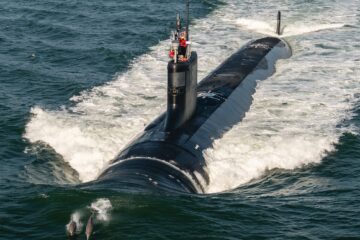The submarines will provide game-changing capability through improved stealth that will reduce their vulnerability, and through a potential increase in hull numbers that will add deterrence capacity, Rear Admiral Oliver Berdal told Naval News.
Together, these two developments will significantly impact the presence and effects the RNoN can generate through its submarine capability.
Norway’s new boat, the Type 212CD submarine, is being built under a German-Norwegian strategic partnership that is delivering T212CDs for both navies. The boat’s propulsion system combines air-independent propulsion (AIP) and hydrogen fuel cell technologies to provide significantly increased dived endurance. “[The submarine] can stay underwater for weeks without exposing itself, and that is the game changer,” said Rear Adm Berdal. “You fundamentally change the vulnerability, because you bring down exposure.”

(Credit: Norwegian Armed Forces)
The design also brings improved acoustic stealth, through a new hull shape, better sound absorption capability, and reduced irradiated noise. “It’s going to be a submarine that is very hard to find,” the admiral noted.
In addition, the T212CD is designed to deliver enhanced situational awareness and networking.
Norway is also considering growing the RNoN’s submarine force level from four to six boats. This would improve availability and presence.
“Any increase … will give a significant increase in the availability of the submarines, but also the deterrent effect.”
Rear Admiral Oliver Berdal
The RNoN’s current submarine force numbers six Type 210 Ula-class diesel-electric submarines (SSKs). However, two will be phased out, with a four-boat level maintained (including through service life-extension work) until the anticipated arrival of the T212CDs by the mid-2030s.
The Ula-class SSKs have already received upgrades including new sensors and a new combat management system. Other planned work includes technical measures to extend the boats’ operational life, said Rear Adm Berdal.

Norway’s Parliament approved the T212CD partnership programme in 2017, with an order following in July 2021. Production work on the RNoN’s first boat began at Germany’s TKMS shipyard, Kiel in September 2023; delivery is expected in 2029.
Norway’s original T212CD order was for four boats. However, in the Norwegian Ministry of Defence’s The Military Advice of the Chief of Defence 2023, published in June 2023, Chief of Defence General Eirik Kristoffersen proposed that the RNoN’s submarine force level should return to six boats.
“Given the economic scope for manoeuvre, the Chief of Defence recommends increasing the number of submarines from four to six,” the report stated. It assessed that stepping up to a six-boat force level would double operational availability, and would increase the armed forces’ ability to counter an adversary’s maritime forces and deny them freedom of operation.

(Credit: Norwegian Armed Forces)
The report explained that submarines will be a key capability for Norway. In maritime terms, they will build RNoN sea denial capacity. Within wider modernisation of Norway’s armed forces, they will support emphases on enhancing situational awareness, mobility, and firepower (the latter, growing capacity to inflict losses on opposing maritime forces).
One technology option to enhance the surveillance and, potentially, firepower output of Norway’s future boats would be the addition of uncrewed capabilities.
The CDS report placed priority on increasing submarine numbers, even compared to (for example) a similar step-up proposed for the RNoN’s frigate fleet.
“An increase from four to six submarines takes higher priority than an increase from four to six frigates.”
CDS report
The increasing threat on Norway’s doorstep is a primary driver here, Rear Adm Berdal explained. Today, he said, Russian submarine capability is greater than at any time over the last 30 years, with steadily increasing numbers of new and very capable boats.
The CDS report pointed to Russia’s reliance on naval bases on the Kola Peninsula and the resultant need for access from the Barents Sea through the Norwegian Sea into the North Atlantic. Russia’s improving submarine capability includes the addition of long-range precision-strike cruise missiles that can reach strategically important targets across Europe and could target allied sea lines of communication (SLOCs) across the North Atlantic.
Rear Adm Berdal underlined the RNoN’s endorsement of the CDS proposal to increase submarine numbers. The proposal will be a central consideration within the armed forces’ wider long-term plan, which will be presented to Parliament in 2024. Any plan for additional boats is, of course, not yet approved. However, to achieve synergies and economies of scale with the current build programme, an investment proposal for more boats would have to be presented shortly after the approval of the long-term plan. “Ideally, any additional submarines would follow at the same drumbeat the existing production is aiming for,” said Rear Adm Berdal.






